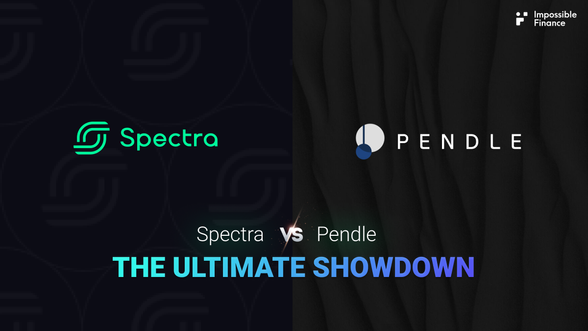
Spectra vs Pendle
AMM Mechanics: Time-Decaying Formula vs. Rate-Adjusted StableSwap
- Pendle ( @pendle_fi ) uses a custom AMM that dynamically adjusts its pricing curve based on the time-value relationship between PT and ST. This design effectively reduces IL for LPs, concentrates liquidity within a reasonable price range, and offers higher capital efficiency and trading precision.
- Spectra ( @spectra_finance ) originally adopted the Curve StableSwap design, an AMM model developed for any tightly pegged assets. However, PT and IBT are not always closely pegged, as the price of PT fluctuates with the implied APY. This made the traditional StableSwap mechanism inefficient in terms of both capital usage and pricing accuracy when handling PT/IBT pairs. To address this issue, the upgraded version of Spectra introduces Rate-Adjusted StableSwap, which integrates interest rate oracles that provide:
- The actual yield of the IBT, derived from the ERC4626 vault
- The fair value of the PT, calculated as a discounted value based on the expected implied APY
This new model:
- Uses the implied APY as a core parameter to dynamically normalize PT and IBT balances into the same underlying asset denomination, allowing the AMM to function as if it were managing pegged assets
- Simultaneously incorporates the difference between the implied APY and the expected implied APY, thereby indirectly embedding the effect of time decay into the AMM’s internal pricing logic.
As a result, Spectra’s AMM achieves significantly higher capital efficiency for PT/IBT pairs within the interest rate market, significantly improving trading efficiency, slippage control, and capital utilization. It is a purpose-built AMM architecture specifically tailored for interest rate trading scenarios.Permissionless vs. Curated MarketsSpectra emphasizes a permissionless framework. Spectra made it easy for anyone to create new yield markets (“permissionless pool creation”), aiming to support a broad array of yield-bearing assets.
- The flexibility of permissionless pools is one of Spectra’s strengths, it opens the door to integrating new yield sources quickly without needing protocol-level upgrades or whitelisting.
- The flip side is potential fragmentation. Spectra’s flexible, permissionless model could result in many small pools, diluting overall liquidity. In contrast, Pendle’s more curated approach concentrates users and capital into a few major markets, which helped it establish strong early network effects. However, Spectra’s newly announced MetaVault feature could be a solution to this issue, potentially consolidating liquidity and improving capital efficiency across pools.
Fee Sharing & token emission
- Pendle
vePENDLE holders
- Receive 80% of swap fees from the pools they vote on- Earn 3% fee from the yield harvested by YT (Yield Tokens)
- Liquidity Providers (LPs)
- Receive 20% of swap fees- Eligible for $PENDLE emissionsWeekly Emission: ~0.0582% of total supply
- Spectra
Following the approval of Spectra Governance Proposal 6 (SGP-6) in early 2025, Spectra adopted a ve(3,3) model for value distribution.
- veSPECTRA holders
- Receive 60% of swap fees from voted pools
Liquidity Providers (LPs) - Receive 20% of swap fees
Curve DAO - Receives 20% of swap fees from all pools (due to Curve AMM integration)
Spectra DAO Treasury - Collects a 3% yield fee on YT redemptions
💸 Weekly Emission: ~ 0.13% of total supplyCan Spectra Close the Gap?
- New AMM Design (released 4/29):
Spectra introduced a new AMM design to significantly enhance capital efficiency with Curve. The new AMM of spectra with improved capital efficiency, now LP can provide low liquidity to make the whole pool works, and the traders can get better price from the new amm.
EditProvide a caption (optional)
EditProvide a caption (optional)
- MetaVaults:
MetaVault is an upcoming feature aimed at automating liquidity rollovers across yield markets. Similar in spirit to Morpho’s vault strategies, it allows users to seamlessly redeploy capital into the next yield cycle without manual withdrawal and reinvestment. This ensures users experience minimal downtime and continuously optimized returns, improving both user experience and TVL retention.My thoughtsPendle currently leads the sector with its optimized mechanics, robust bribe economy, and carefully curated yield markets. However, Spectra has shown its potential most notably through its partnership with Resolv ($USR), which triggered a rapid spike in TVL.The key challenge for Spectra now is onboarding major protocol partners to drive TVL growth. The recent launch of Hemi on Spectra is a promising signal that they're starting to attract interesting and credible projects. Technically, Spectra is well-equipped, with a newly designed AMM capable of enabling high capital efficiency for interest rate trading.If Spectra can capture even 10% of Pendle’s market share, $SPECTRA would be deeply undervalued at current prices. Its ve(3,3) model further aligns token value with protocol usage, creating strong reflexivity. Meanwhile, the upcoming Metavault could serve as a powerful liquidity engine, reinforcing Spectra’s positioning as a go-to venue for PT and YT trading.In short, the infrastructure is ready. All it takes now is a few strong partnerships or newly launched interest-bearing tokens to ignite the next wave of growth.
Reference:
https://x.com/GaspardPeduzzi/status/1907362218015953302
https://x.com/0xCoinshift/status/1901646735426072812
https://www.gate.io/zh-tw/learn/articles/pendle-vs-spectra-who-s-winning-the-de-fi-yield-race/8090
https://gov.spectra.finance/t/sgp-6-update-of-fee-collection-and-distribution/566
https://docs.spectra.finance/https://docs.pendle.finance/
